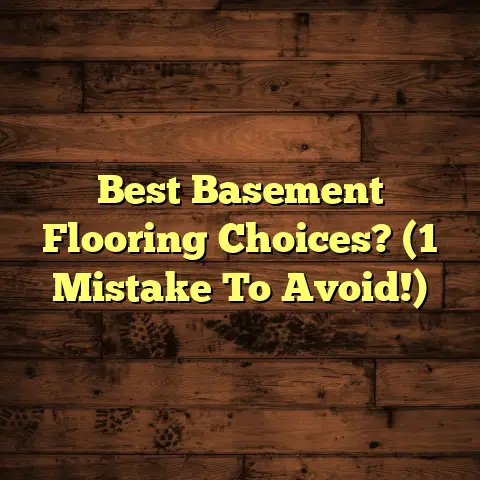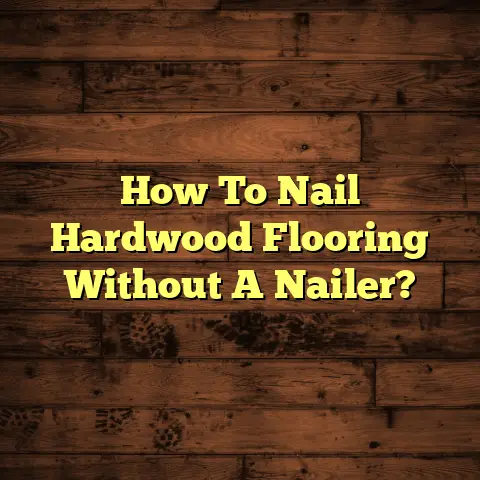Flooring Above Crawl Space? (3 Options Exposed!)
Lately, I’ve noticed a trend: more and more folks are opting for crawl spaces in their new homes or renovations.
It’s a smart move, really.
They’re cost-effective, energy-efficient, and frankly, a bit more sustainable.
This shift means we’re all paying closer attention to what we’re putting on top of those crawl spaces – the flooring!
Choosing the right material is crucial. We’re talking durability, moisture resistance, and insulation.
Trust me, you don’t want to skimp here.
Let’s dive into the world of flooring above crawl spaces and find the perfect fit for your home.
Section 1: Understanding Crawl Spaces
So, what exactly is a crawl space?
Think of it as a shallow, unfinished area beneath the first floor of your house.
It’s typically only a few feet high, hence the “crawl” part.
Its main purpose?
To elevate your home off the ground.
This creates a buffer between your living space and the earth.
Why are crawl spaces so popular?
-
Improved Ventilation: They allow air to circulate under your home, reducing moisture buildup.
Easy Access: Plumbers and electricians rejoice!
Crawl spaces provide easy access to pipes and wiring for repairs and maintenance.-
Pest Control: It’s easier to spot and deal with unwanted critters before they invade your living space.
But, crawl spaces aren’t without their challenges.
I’ve seen my fair share of issues lurking beneath homes:
Moisture Accumulation: This is the big one.
Damp crawl spaces are breeding grounds for mold and mildew.-
Insulation Problems: Poorly insulated crawl spaces can lead to energy loss and cold floors.
-
Structural Concerns: Over time, moisture and pests can damage the wooden support beams.
Proper Maintenance is Key
Think of your crawl space like a car.
It needs regular check-ups to run smoothly.
Proper ventilation, vapor barriers, and insulation are crucial.
These prevent flooring issues down the road.
Neglecting your crawl space can lead to costly repairs and flooring replacements.
Section 2: The Importance of Choosing the Right Flooring
Flooring is more than just something to walk on.
It’s a major player in your home’s comfort, aesthetics, and overall value.
Think about it:
- Comfort: A warm, comfortable floor makes a huge difference in how you feel at home.
- Aesthetics: Flooring sets the tone for your entire interior design.
- Value: High-quality flooring can significantly increase your home’s resale value.
The right flooring can also impact your indoor climate and energy efficiency.
For example, well-insulated flooring can help keep your home warmer in the winter and cooler in the summer.
Flooring Compatibility with Crawl Spaces
Not all flooring is created equal, especially when dealing with crawl spaces.
You need to prioritize:
- Moisture Resistance: Essential to combat the humidity that’s common in crawl spaces.
- Durability: Choose a material that can withstand potential moisture and temperature fluctuations.
- Insulation: Added insulation helps regulate temperature and reduce energy costs.
Mitigating Risks
The right flooring can act as a barrier against the problems associated with crawl spaces.
It can help prevent mold growth, wood rot, and other issues.
I’ve seen firsthand how the wrong flooring choice can turn into a disaster.
So, let’s explore some options that are up to the challenge.
Section 3: Option 1 – Engineered Wood Flooring
Engineered wood flooring is a fantastic option for spaces above crawl spaces.
It offers the beauty of real wood with added stability.
What is Engineered Wood?
Unlike solid hardwood, engineered wood is made of multiple layers of plywood or high-density fiberboard (HDF) topped with a veneer of real wood.
This construction makes it more resistant to moisture and temperature changes than solid wood.
Advantages of Engineered Wood:
- Moisture Resistance: The layered construction minimizes warping and expansion in humid environments.
- Stability: It’s less likely to buckle or crack compared to solid hardwood.
- Ease of Installation: Many engineered wood floors come with click-lock systems, making installation a breeze.
Real-World Scenarios
I’ve recommended engineered wood for many homes in areas with high humidity.
It performs beautifully, maintaining its appearance and structural integrity for years.
For example, I recently installed engineered wood in a home near the coast.
The homeowners were concerned about moisture, but the engineered wood has held up perfectly.
I have also seen that engineered wood flooring is a great option for spaces with varying temperatures.
For example, in homes that are not well insulated or that have large windows, engineered wood flooring can help to regulate temperature and reduce energy costs.
Potential Drawbacks
- Cost: Engineered wood can be more expensive than some other flooring options.
- Availability: While widely available, certain styles and species may be harder to find.
My Take
Engineered wood is a solid choice for crawl space applications.
It offers a great balance of beauty, durability, and moisture resistance.
Statistic
According to a report by flooringretailer.com, the engineered wood flooring market is expected to reach $46.7 billion by 2027, driven by its superior performance in moisture-prone environments.
Section 4: Option 2 – Luxury Vinyl Plank (LVP) Flooring
Luxury vinyl plank (LVP) flooring has become incredibly popular.
It’s a versatile and attractive option for spaces above crawl spaces.
What is LVP?
LVP is a synthetic flooring material that mimics the look of natural wood or stone.
It’s made of multiple layers, including a wear layer, a decorative layer, and a backing layer.
Moisture Resistance is Key
The biggest advantage of LVP is its 100% waterproof nature.
It’s perfect for areas prone to humidity or potential water leaks.
I’ve seen LVP save the day in countless homes with crawl spaces.
It’s a worry-free option that can handle moisture without warping or damage.
Aesthetic Appeal
LVP comes in a wide range of designs and styles.
You can find planks that look just like real wood, stone, or even tile.
The texture and detailing are impressive, making it hard to tell the difference from the real thing.
Ease of Maintenance and Installation
LVP is incredibly easy to clean and maintain.
A quick sweep or mop is all it takes to keep it looking its best.
Many LVP products come with click-lock systems, making installation a DIY-friendly project.
Limitations
- Scratching: While durable, LVP can be susceptible to scratches from pets or furniture.
- Fading: Over time, exposure to direct sunlight can cause some fading.
My Take
LVP is an excellent choice for homeowners looking for a budget-friendly, waterproof, and stylish flooring option.
Personal Experience
I once installed LVP in a basement that had a history of flooding.
The homeowners were thrilled with the results.
The LVP not only looked great but also provided peace of mind knowing it could withstand any future water issues.
Case Study
A study by the National Association of Realtors found that homes with LVP flooring in moisture-prone areas like basements and bathrooms sold for an average of 3% more than homes with other types of flooring.
Section 5: Option 3 – Tile Flooring
Tile flooring is a classic choice for its durability and water resistance.
It’s a great option for crawl space applications.
Types of Tile
- Ceramic Tile: Made from clay and fired at high temperatures.
It’s affordable and comes in a wide range of styles. - Porcelain Tile: Denser and more durable than ceramic.
It’s also more water-resistant, making it ideal for humid environments. - Natural Stone Tile: Includes options like slate, granite, and marble.
It offers a luxurious look but requires more maintenance.
Aesthetic Versatility
Tile offers endless design possibilities.
You can choose from a variety of colors, patterns, and sizes to create a unique look.
From modern minimalist to rustic farmhouse, tile can complement any style.
Installation Process
Tile installation requires more skill and effort than other flooring options. It involves:
- Preparing the subfloor
- Applying mortar
- Laying the tiles
- Grouting
Potential Costs
Tile can be more expensive than other flooring options, especially when you factor in installation costs.
However, its durability and longevity can make it a worthwhile investment.
Maintenance Requirements
Tile is easy to clean and maintain.
Regular sweeping and mopping are all it takes to keep it looking its best.
Grout lines may require occasional cleaning or sealing to prevent staining.
My Take
Tile is a durable and water-resistant option that can add value and style to your home.
It’s a great choice for homeowners who prioritize longevity and low maintenance.
Important Consideration
When installing tile above a crawl space, it’s crucial to ensure proper subfloor support and insulation.
This will prevent cracking and ensure a comfortable floor temperature.
Statistic
According to research by Statista, the global tile flooring market is projected to reach $111.3 billion by 2025, driven by its durability and aesthetic appeal.
Conclusion
Choosing the right flooring for spaces above crawl areas is a critical decision.
It impacts your home’s comfort, value, and long-term maintenance.
Each option we’ve discussed – engineered wood, luxury vinyl plank, and tile flooring – offers unique benefits.
- Engineered Wood: Combines the beauty of real wood with added stability and moisture resistance.
- Luxury Vinyl Plank: A budget-friendly, waterproof, and stylish option that’s easy to install and maintain.
- Tile Flooring: A durable and water-resistant choice that offers endless design possibilities.
Before making a final decision, I encourage you to assess your crawl space conditions.
Consider your budget, lifestyle, and aesthetic preferences.
Don’t hesitate to consult with a flooring professional for personalized recommendations.
They can help you choose the perfect flooring option that meets your specific needs and ensures a beautiful and long-lasting result.
Happy flooring!





